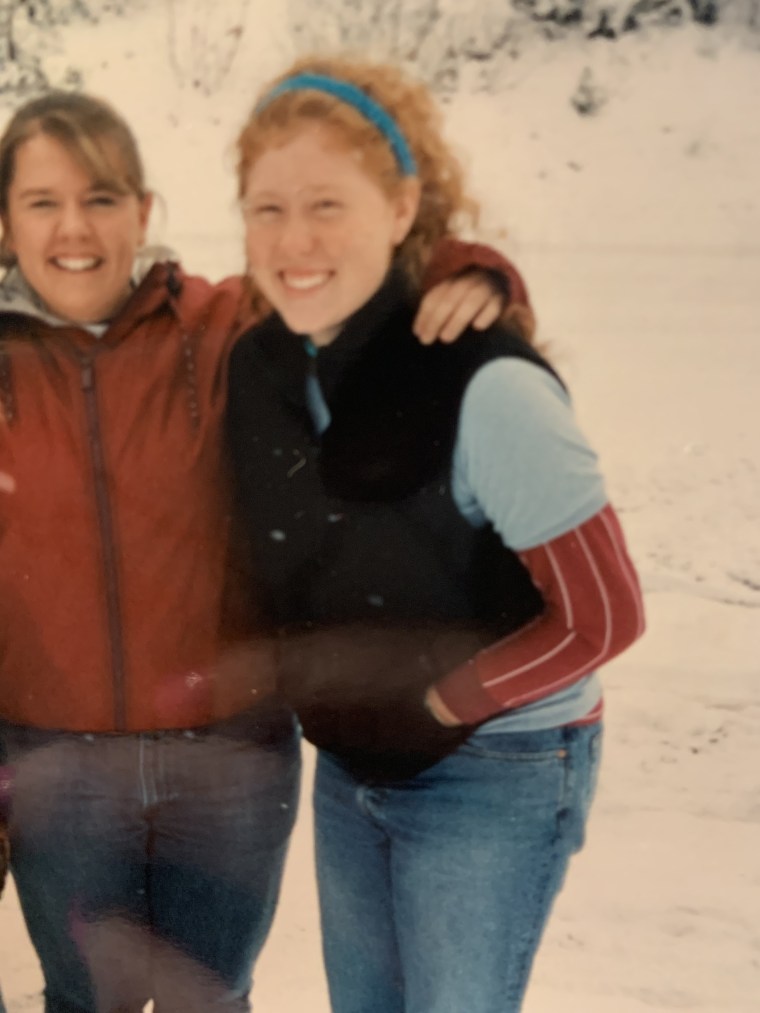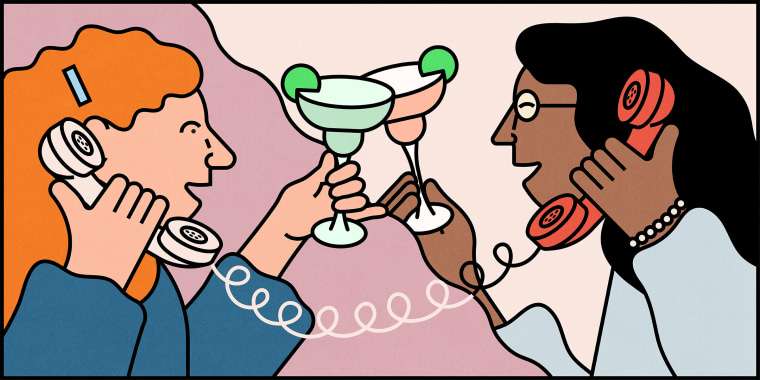We were talking about jeans. When we should have been carefully studying our volleyball teammates on the court, or at the very least cheering them on, Lacey and I were in a deep discussion about the acute agony of trying on jeans with our moms, a trauma only two tweens forced to wear Catholic school uniforms 95% of the year could truly appreciate. This was 1995 and if there was one thing 12-year-olds could agree on, it was the injustice of denim.
“My mom will be like, ‘We can make ‘em fit!’” I told Lacey, prompting our coach to rebuke us for laughing when we should have been in game mode.
Inside jokes like these would become the foundation of our friendship. When you’re in middle school, finding a pal to commiserate with is a matter of survival, and I found the very best. And then in high school, whether it was skipping class to grab Starbucks or throwing shot put and discus together (are you getting a visual of how cool we were?), we rarely did anything apart. Teachers and students alike were freaked out when they’d encounter one of us without the other — we were that connected.

So it’s remarkable that even though we put 3,000 miles between us in college and have spent at least two-thirds of our friendship that far away, we’re still best friends. A real feat for two wildly different people: I think of Lacey as calm, cool and collected, whereas I tend to be a bit more high-strung. She’s raising three beautiful children. I have one. She grew up in a farm family. I was raised by a dentist and actress. Any algorithm would likely say we’re not a match, but I can’t imagine my life without her — the only adult woman who can make me laugh so hard I shoot margarita out my nose (true story).
Part of it is luck. I just happened to sit next to a super loyal gal that day in the gymnasium. But more likely, it’s the effort we both put into staying close, even as we were physically apart.
People often talk about how to make long-distance relationships work, but what about long-distance friendships? To figure out how we can all better nurture and maintain our own, I turned to some experts.
Communication matters — and it doesn’t have to be IRL
Marissa Franco, a psychologist and friendship expert, told TODAY that my and Lacey’s regular phone calls, emails and many, many text messages over the past three decades are what’s kept our platonic bond alive even with an entire nation between her home near Seattle and mine in rural Virginia.
But it’s not just about communicating — it’s about how we communicate.
“Sharing vulnerability tends to make us feel a lot more connected,” Franco said. “Asking for support and being willing to give it is really a portal to deep intimacy if we’re willing to be upfront about our needs and also show up for each other.”
Sharing vulnerability tends to make us feel a lot more connected.
marissa franco, psychologist
We could all use these deeper relationships, be it with a friend next door or a friend three states away, now more than ever, she added.
“Americans are very lonely right now,” Franco said, comparing the effects of loneliness to a habit as toxic as smoking.
For people concerned about not seeing long-distance friends in person — especially as the pandemic has ruined so many of our travel plans — there’s good news: Research suggests that friendships can flourish even without face-to-face interactions.
In her doctoral dissertation at the University of Tennessee, Jessica Thern Smith studied 36 women from three different age groups about their long-distance friendships and found that “relationships are not solely based on proximity and frequent face-to-face interaction; instead, friendships can exist across telephone lines, in cyberspace and even within our minds.”

In other words, it doesn’t matter that Lacey and I might not see each other more than twice a year. What matters is that we’re there in spirit.
Long-distance friendships can be especially rewarding
The idea of rekindling a long-distance friendship might sound daunting, but Shasta Nelson, the author of “Frientimacy,” said it’s worth the effort.
“We replace half our close friends every seven years,” Nelson said. “The ones who tend to make it are the ones we figure out how to maintain past changes.”
That means that our long-term and even long-distance friendships might just be the ones that have the greatest potential. Consider how much probability plays into who we befriend. You meet a person in a fitness class or bond with another adult on a playground, but as life shifts, you might not see that person as much and then that brief relationship can fade to the background. But a solid long-distance friend doesn’t require a coincidental run-in at the local coffee shop or grocery store. You can just pick up the phone and call them at any time.
Consistency and reciprocity are key
Both Franco and Nelson agree that putting regular calls on the calendar with a long-distance pal can make all the difference in maintaining a friendship.
“Consistency is correlated with vulnerability,” Nelson said. “The more often we’re talking and hearing about each other, the more meaningful it actually becomes.”
Nelson has more advice: Balance the conversation. “Mutual sharing is going to be key to making that relationship work,” she said. You know the old phrase “pass the mic”? Well, that pertains here as well. You can’t hog the conversation. Both parties need to feel like they were able to share both the highs and lows in their life and come away from the call feeling heard.
“We have to find a rhythm,” added Nelson. “Otherwise the friendship won’t feel as meaningful on an ongoing daily basis.” That means that both parties take the time to make the time. It can’t always be one friend reaching out, making the call or sending the text.
It can’t always be one friend reaching out, making the call or sending the text.
“The other thing that’s really helpful is to just express positivity and affection toward each other — like, ‘I really value you, I appreciate you. I always look forward to talking to you. You’re so important to me,’” Franco said. “It tends to cement the bond more.”
In that case, let me say it here and now in this highly public forum for all the internet to read: Lacey, I love ya, girl. Now let’s pick a date for a call over margaritas.
